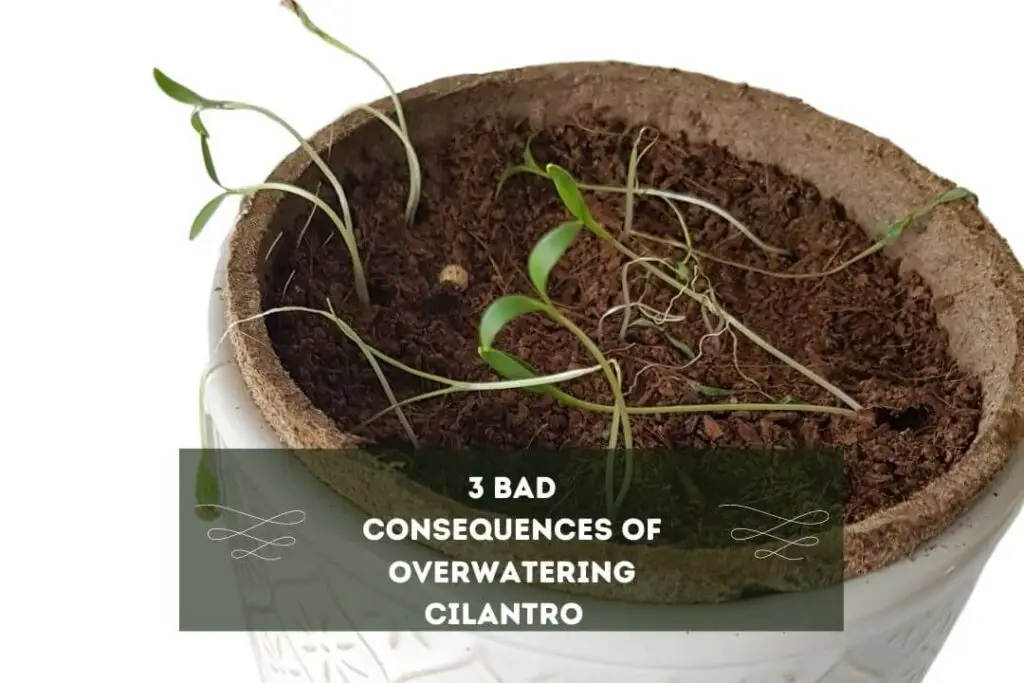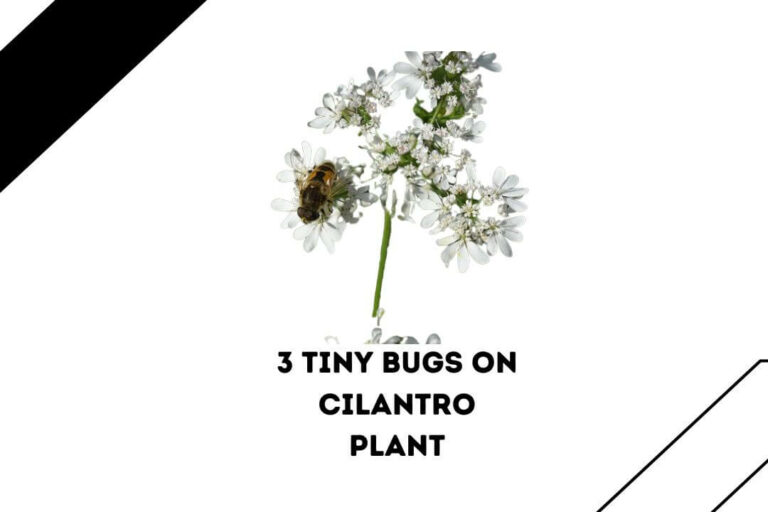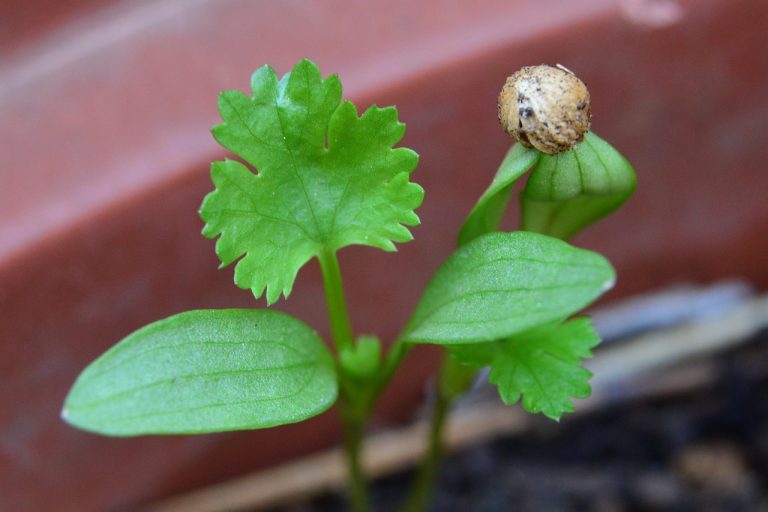If you are struggling with your overwatered cilantro, don’t worry because you’re not alone. Overwatering can cause cilantro to wilt, turn yellow, or even die; it is essential to understand how you save your plant.
Fortunately, it’s not too late to keep your overwatered cilantro. With a little effort and patience, you can quickly revive your overwatered cilantro and help it thrive again. In this article, I’ll share seven easy steps that you can follow to save your overwatered cilantro and keep it healthy.
Cilantro Overwatering Signs
Since Overwatering is a common problem that can affect the health of your cilantro, you must learn the signs.
| Signs of Overwatering | Signs of Underwatering |
| Wilting or drooping | Wilting or drooping |
| Yellowing leaves | Yellow leaves on cilantro |
| Root rot | Dry, brittle leaves |
| Slow growth or stunted | Stunted growth |
| Foul odor | Crispy, brown leaves |
However, if your cilantro plant turns yellow (or red in rare cases), other causes or factors can be involved that need a deep inspection. Never mind taking a quick on our other guide to know 7 possible reasons why is my cilantro plant turning yellow. Or, you can check 7 Possible Reasons Cilantro Leaves Turning Red & 3 Risks
How To Revive Overwatered Cilantro?

Firstly you need to reduce the watering frequency and ensure your pot soil is well-draining. Then, prune damaged leaves to help your plants focus on new growth. Also, it improves air circulation because cilantro prefers moderate to high humidity.
As you know, Overwatering is a common problem that can cause cilantro to suffer; you need to follow a proper and systematic approach to revive your overwatered cilantro and bring it back to life.
Every plant has its requirement and tends to be different from others. Therefore to help you out, I am giving you five easy steps below with proper instructions and explanations that you need to know to revive your overwatered cilantro.
Step 1: First, Assess The Damage By Checking the Root System.
According to the University of Minnesota Extension, you should always check the root system for rot or mold. If you notice your cilantro is drooping, yellowing, or showing other signs of overwatering, take a moment to examine it closely. Root rot and mold are among the most common indications of overwatering, indicating you need to adjust your watering habit.
Step 2: As Per Requirement, Adjust Your Watering Habits
I don’t need to tell you that overwatering is often caused by watering your plant too frequently. Therefore first, you need to adjust your watering habit. To revive your cilantro, As Gardenista recommends, only Water your cilantro when the soil is dry to the touch.
I will advise you to dip your finger into the ground and see if it feels try. Also, you should ensure the water is evenly distributed throughout the earth.
Step 3: Prune away damaged leaves to help the cilantro focus on new growth.
According to the Old Farmer’s Almanac, removing damaged leaves will encourage new growth. Therefore I will advise you to prune away any damaged or wilted leaves after you’ve adjusted your watering habits. Removing the damaged leaves will help your cilantro to focus on new growth rather than trying to recover the damage.
Step 4: Improve air circulation
Since you have adjusted the water frequency, you should consider improving the year circulation to prevent mold and mildew from forming. If you have planted your cilantro in a pot, I will advise you to move it to an area with better air circulation. However, if your cilantro is planted on the ground, I recommend avoiding producing any other plant nearby.
Step 5: Add organic fertilizer to replenish lost nutrients
Do you know that Overwatering can cause nutrients to leach out of the soil, directly affecting your ‘plant’s ability to grow and thrive? In such a case, your cilantro will starve for its nutrients to thrive. I highly advise you to consider adding a balanced organic fertilizer. This will help replenish these lost nutrients and support healthy growth.
To fully recover your cilantro plant will need several weeks for sure. This is why I recommend you be patient and not expect to see results overnight. However, you should save by saying new growth or improvement in a few days.
You should note that reviving an overwatered plant takes time and patience. If you follow all the steps systematically, you will restore your overwatered cilantro and make it thrive again. Always remember that prevention is better than cure.
Therefore I recommend you adjust your watering habit and pay attention to your plant needs. Never water your cilantro if its soil is still moist. Apart from this, you should also offer a sound drainage system.
You will likely face a few bizzare consequences if you continue over-watering your cilantro. By being aware of these consequences, you can avoid overwatering your cilantro and keep it healthy and thriving.
Do you know that you can also consider growing Cilantro in an Aerogarden?
3 Bad Consequences Of Overwatering Cilantro

I hope you know that overwatering cilantro can have serious consequences that can harm your plant’s health and productivity. Below you will find three main products of overwatering cilantro and provide tips on how to avoid them.
Root Rot
As I told you, Overwatering can lead to root rot. This is a severe condition where the roots become saturated with water, depriving the plant of oxygen. If you ignore it, root rot can lead to wilting, yellowing, and eventual death of the plant.
Signs Of Root Rot
- Brown Root.
- Mushy Roots.
- Foul Odour.
- Yellowing Leaves.
- Black Root
I will highly advise you to only water your cylinder if you feel the soil is dry and ensure good drainage in your soil or pot.
Fungal Diseases
Overwatering can create a damp environment that is perfect for fungal growth. As per the University of California Agriculture and Natural Resources, continuing to overwater your cilantro can lead to fungal diseases like bacterial leaf spots. If you don’t adjust the water immediately, it will lead to severe conditions like powdery mildew and leaf spot.
Signs Of Fungal Diseases
- the white or grey powdery coating on leaves
- yellow or brown spots on leaves
- wilting or curling leaves.
If you want to prevent this, I will first advise you to avoid overhead watering. After that, increase air circulation and prune away affected leaves.
Nutrient Deficiencies
As I told you earlier, overwatering can cause nutrients to be washed away from the soil, leaving your cilantro starved of the nutrients it needs to grow and produce healthy leaves.
Signs Of Nutrient Deficiencies
- Stunted growth,
- Yellowing Leaves
- Poor Flavor
This is why I highly advise you to fertilize your cilantro with a balanced organic fertilizer regularly. But before that, you should check the soil quality by getting a sample to the lab to determine what nutrients it lacks.
Thus, If you keep the plant soil waterlogged, it will die no matter how much you try to regrow them. I will advise you to consider taking a quick look at our recent article on 9 reasons why my cilantro keeps dying.
Conclusion
As you know, overwatering cilantro can have serious consequences that can ultimately harm your cilantro health & productivity; you first need to reduce the water frequency. Following the tips I’ve provided in this article, you can get your cilantro back to normal health.
I highly recommend you watch for signs of overwatering and prevent it from recurring. With the proper care and approach, your cilantro will flourish again. I tried my best to give you all the information you need to know on overwatered cilantro.
If you find this article helpful, then consider sharing it. Your share will help many people revive their overwatered cilantro back to its normal health. Do check our other practical guide on cilantro care and management. See you in the next post, till then take care and goodbye.






